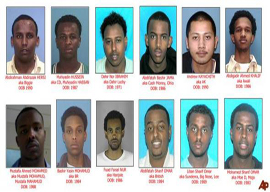
August 08, 2011

Somali Sex Trafficking Arrestees
Let’s consider ourselves fortunate that Canada’s Somali settlers—the word “immigrant” is so 20th century—seem more or less content with killing each other.
On the last day of July, the Edmonton Journal devoted not two, not three, but seven articles to the latest spate of intra-Somali murders in Alberta’s capital.
(Nicknamed “Deadmonton,” that city leads Canada in homicides this year, with 29 so far—four of those victims being Somali “youths.”)
The Edmonton Journal depicts a community of approximately 10,000 self-effacing newcomers scratching out modest livings and shaken by the statistically significant number of dead sons they’ve been obliged to bury.
Amazingly, the Somalis they interviewed didn’t use “victimhood” jargon when discussing the murders. Only a Somali-born “youth worker” raised the specter of racial “discrimination.”
Instead, these engineers-turned-cabdrivers explained, without discernible self-pity, that the young men who’d been killed had traveled across Canada to cash in on Alberta’s abundant oil wealth. Unable to find work upon arrival and separated from their families, they succumbed to the lure of easy money by selling drugs and running guns. Some paid with their lives.
Discussing the murders elsewhere, Ahmed Hussen of the Canadian Somali Congress also sounded so unlike the typical “professional ethnic” that his interviewer seemed taken aback.
Hussen stated, “We haven’t sat around waiting for the government and the police to solve this. We have taken complete ownership of this issue.”
Among other things, such as a “youth help line,” the locals launched a poster campaign encouraging residents to cooperate with police. (Somalis brought their distrust of armed, uniformed authorities with them from their homeland, which helps explain why only three of those 18 murders have been solved.)
But speaking of cultural “baggage,” some of it might have gotten lost on the trip to the printing press.
Anyone familiar with the problems created by Somali immigrants to the West will note that none of the Journal’s articles includes the word “khat” or the phrase “female genital mutilation.”
Even the Los Angeles Times and Canada’s National Post have reported on the staggering obstacles to Somali assimilation, such as the need for classes explaining that wife-beating is illegal, along with the chronic use of the illegal stimulant khat.
Khat, or gat, is a shrub that grows in East Africa and the Arabian Peninsula. Legend has it that Bushmen chewed khat to stay awake during long hunting expeditions. Its effect is said to be comparable to either coffee or cocaine, depending on whom you ask: a three-or-so-hour “high” characterized by increased energy, reduced inhibition, and, notably, talkativeness.
Canadian authorities now seize more khat than cocaine, heroin, opium, crack, and meth combined, including a large shipment that landed in Fort McMurray, Alberta a few weeks ago.
Perhaps Edmonton Journal reporters are singularly incurious or naive. Consider this excerpt from one of their July 31 features:
Cafe culture is part of Somali life. Men gather to debate politics in fadhi ku dirir—politics by sitting and talking. It’s lively, engaging conversation.
Compare it to the National Post’s expose on Toronto’s khat trade:
In Somalia, chewing khat is a daily ritual that dates back hundreds of years. Men gather in the baking afternoons to sit, chew and talk. Khat sessions can last all night.